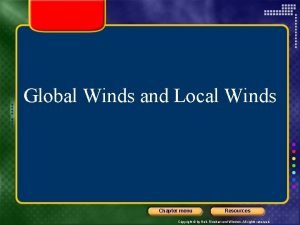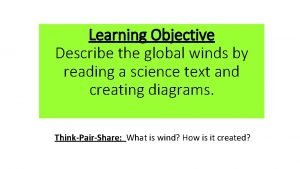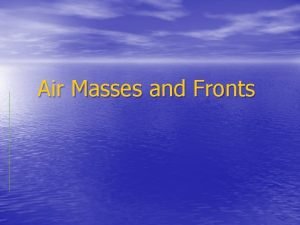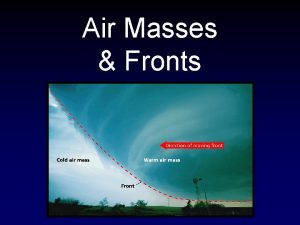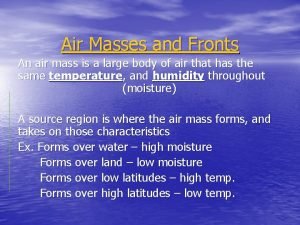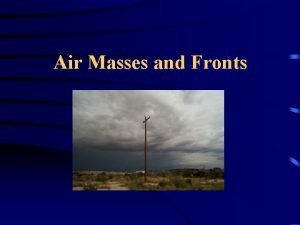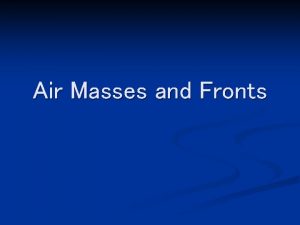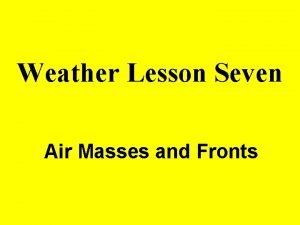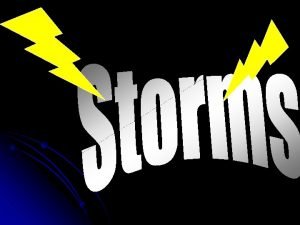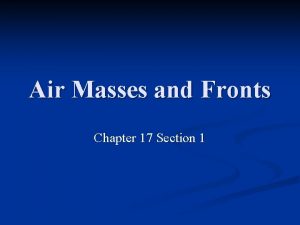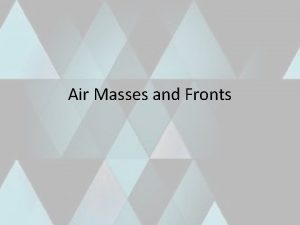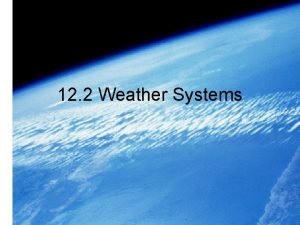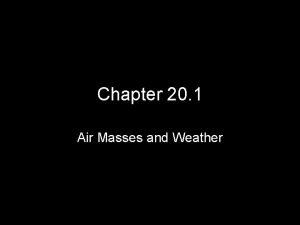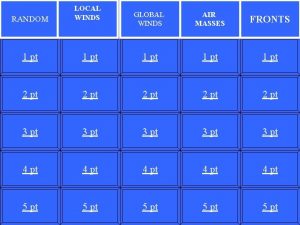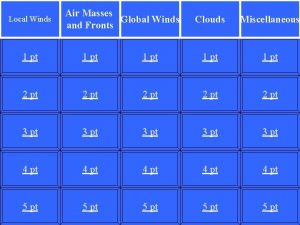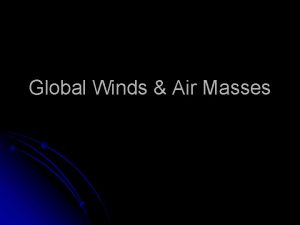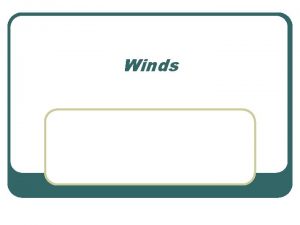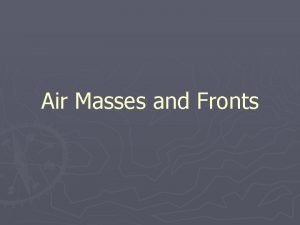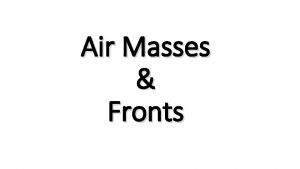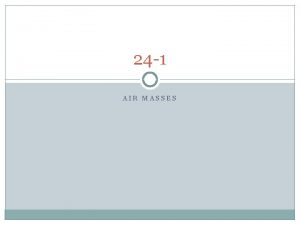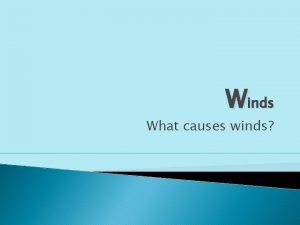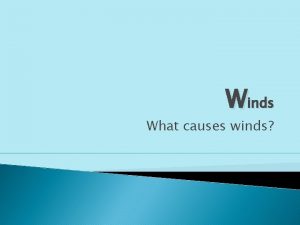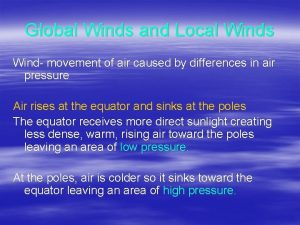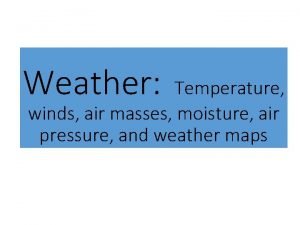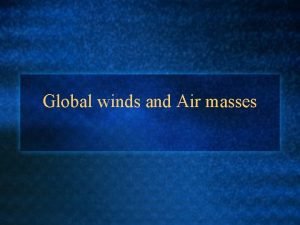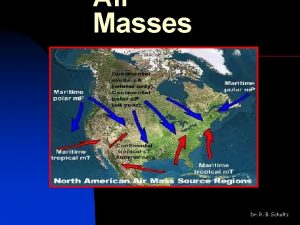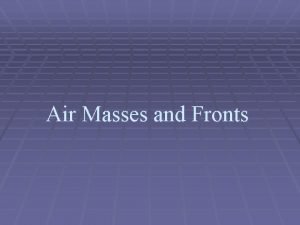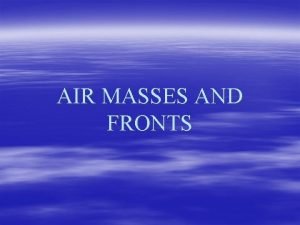Movement of Air Air Masses Winds Air Masses
























- Slides: 24

Movement of Air – Air Masses & Winds

Air Masses Air Mass = large body of air that takes on characteristics of the area over which it formed Conditions: Over land = dry Over water = wet Polar regions = cold Tropical regions = warm

Air Masses Types of Air Masses: Continental polar (c. P) – cold, dry Continental tropical (c. T) – warm, dry Maritime polar (m. P) – cold, wet Maritime tropical (m. T) – warm, wet Equatorial – hot


Winds When air is heated: Its density decreases Warm air rises, produces an area of low pressure Cooler denser air produces an area of high pressure, and moves in under rising air

Local winds Sea breeze –during the day solar radiation warms the land more than water air moves inland from the ocean due to air over land heating up quicker (and is less dense than the ocean air) Land breeze –at night when cool air from land flows seaward air moves toward the ocean as the land air cools quicker

Land Sea Breezes

Fronts Air masses move and bump into each other Fronts appear at the edges of two air masses where they are colliding with each other

Fronts There are 4 types of fronts: Cold fronts Warm fronts Stationary fronts Occluded fronts

Cold front Occurs when a cold air mass overtakes a warm air mass Cold air forces warm air to rise quickly Resulting in strong winds, thunderstorms, and large amounts of precipitation

Cold fronts usually bring cooler weather, clearing skies, and a sharp change in wind direction.

Cold Front

Cold Front Diagrams

Warm Fronts Occurs when a warm air mass overtakes a cold air mass Warm air slowly rises over the cold air Starts with steady rain (8 -12 hours) but eventually clears when temperatures rise Warm fronts tend to move slowly are far less violent then cold fronts

After warm front passes, weather becomes warm and humid, but generally clear

Warm Front

Warm Front Diagrams

Stationary Front When neither air mass can move the other Similar to warm fronts and can remain in same place days Light wind and precipitation occur across entire region affected



Occluded front When a warm air mass gets trapped between two cold air masses Strong winds and heavy precipitation occur



 6winds
6winds What is the difference between global and local winds?
What is the difference between global and local winds? Global winds and local winds worksheet answers
Global winds and local winds worksheet answers Narrow belts of high speed winds
Narrow belts of high speed winds Wind belts
Wind belts Air masses & frontswhat is an air mass?
Air masses & frontswhat is an air mass? Two cold air masses converge on a warm air mass
Two cold air masses converge on a warm air mass Polar air masses have low air pressure true or false
Polar air masses have low air pressure true or false Whats an air mass
Whats an air mass Air masses & frontswhat is an air mass?
Air masses & frontswhat is an air mass? Air masses & frontswhat is an air mass?
Air masses & frontswhat is an air mass? Air masses & frontswhat is an air mass?
Air masses & frontswhat is an air mass? Maritime tropical air mass symbol
Maritime tropical air mass symbol Air masses
Air masses Area of low pressure where air masses meet and rise
Area of low pressure where air masses meet and rise Importance of air masses
Importance of air masses Meteorological symbols for four types of fronts
Meteorological symbols for four types of fronts Mt air mass
Mt air mass Air masses form in the tropics and have low pressure
Air masses form in the tropics and have low pressure Air fronts
Air fronts North american air masses
North american air masses Occluded front
Occluded front Air masses in north america
Air masses in north america Types of air masses
Types of air masses Front
Front



